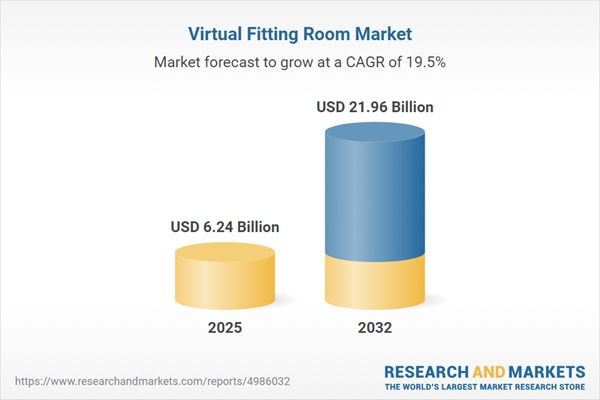Speak directly to the analyst to clarify any post sales queries you may have.
The virtual fitting room market is rapidly transforming the retail sector, empowering brands to deliver immersive digital try-on experiences that address evolving consumer expectations and operational needs.
Market Snapshot: Virtual Fitting Room Market Growth and Trajectory
The virtual fitting room market grew from USD 5.26 billion in 2024 to USD 6.24 billion in 2025, and is forecasted to advance at a CAGR of 19.53%, reaching USD 21.96 billion by 2032. Market expansion is driven by technological innovation, increased mobile adoption, and the growing demand for differentiated, convenient shopping experiences. As digital try-on solutions become a strategic priority for retailers and brands, the industry is set for robust evolution across applications and geographies.
Scope & Segmentation
This comprehensive report details current trends, growth drivers, and strategic developments in the virtual fitting room landscape. The analysis encompasses:
- Technology: Artificial Intelligence (AI)-powered, Augmented Reality (AR), Virtual Reality (VR)
- Pricing Model: Pay Per Use, Subscription-Based
- Deployment: Cloud Based, On Premises
- Application: Apparel (Accessories, Clothing, Footwear), Beauty & Cosmetics, Eyewear, Jewelry & Watches
- Customer Type: Enterprise Solutions, Individual Consumers
- Geographic Coverage: Americas (United States, Canada, Mexico, Brazil, Argentina, Chile, Colombia, Peru), Europe, Middle East & Africa (United Kingdom, Germany, France, Russia, Italy, Spain, Netherlands, Sweden, Poland, Switzerland, United Arab Emirates, Saudi Arabia, Qatar, Turkey, Israel, South Africa, Nigeria, Egypt, Kenya), Asia-Pacific (China, India, Japan, Australia, South Korea, Indonesia, Thailand, Malaysia, Singapore, Taiwan)
- Key Companies Profiled: 3DLOOK Inc., AstraFit, Bold Metrics Inc., ELSE Corp, Fit Analytics GmbH, FXGear Inc., Intelistyle, Magic Mirror, MemoMi, Metail, MySize, Perfitly, PRIME AI LTD., Reactive Reality GmbH, Sizebay, Texel Ltd., True Fit Corporation, Virtual On Ltd., Virtusize, ViuBox, Zalando SE, Zugara, Inc.
Key Takeaways for Senior Leaders
- Artificial intelligence and augmented reality are enabling highly accurate virtual fittings that foster greater consumer trust in online purchases.
- Enhanced integration with e-commerce platforms and CRM tools is allowing brands to provide more personalized product recommendations and drive targeted marketing.
- Efforts toward sustainability are evident, as virtual try-on solutions help reduce return rates and excess packaging waste, optimizing logistics and environmental impact.
- Global deployment is driven by strong adoption in North America and emerging market initiatives in Asia Pacific, with local preferences influencing solution design and functionality.
- The ability to deliver flexible deployment—cloud or on-premises—allows enterprises to align solution architecture with internal IT requirements and regulatory mandates.
- Continuous partnerships between technology providers and retailers are accelerating market maturity, with cross-border collaborations supporting platform localization and innovation.
Tariff Impact: Navigating U.S. Trade Shifts
The 2025 U.S. tariff regime is increasing costs for hardware such as sensors and cameras, prompting solution providers to reassess supply chains and procurement. Some vendors are investing in domestic manufacturing or optimizing platforms for software-centric deployment, reducing reliance on specialized imports. Retailers are adjusting contracts, shifting toward cost-efficient models, and leveraging partnerships within free trade zones to maintain competitiveness and mitigate price volatility.
Methodology & Data Sources
This report utilizes a hybrid research methodology, drawing from primary interviews with industry stakeholders including technology leaders, retailers, and solution architects. Structured surveys were conducted with both enterprise users and consumers to validate adoption patterns and preferences. Secondary research was performed using industry publications, patent analysis, and financial disclosures. Scenario analysis and proprietary data modeling provide further analytical depth and reliability.
Why This Report Matters
- Equips decision-makers with a clear assessment of technology and pricing models across all key regions and use cases.
- Delivers actionable insights for supply chain risk mitigation and regulatory compliance in light of shifting international trade policies.
- Supports the development of customized deployment strategies, aligning investment with consumer engagement and industry best practices.
Conclusion
Virtual fitting rooms are redefining digital commerce by merging advanced technologies with intelligent retail strategy. Armed with segment-level insights and actionable guidance, leaders are positioned to transform consumer engagement, streamline operations, and capitalize on emerging opportunities in this dynamic market.
Additional Product Information:
- Purchase of this report includes 1 year online access with quarterly updates.
- This report can be updated on request. Please contact our Customer Experience team using the Ask a Question widget on our website.
Table of Contents
3. Executive Summary
4. Market Overview
7. Cumulative Impact of Artificial Intelligence 2025
Companies Mentioned
The companies profiled in this Virtual Fitting Room market report include:- 3DLOOK Inc.
- AstraFit
- Bold Metrics Inc.
- ELSE Corp
- Fit Analytics GmbH
- FXGear Inc.
- Intelistyle
- Magic Mirror
- MemoMi
- Metail
- MySize
- Perfitly
- PRIME AI LTD.
- Reactive Reality GmbH
- Sizebay
- Texel Ltd.
- True Fit Corporation
- Virtual On Ltd.
- Virtusize
- ViuBox
- Zalando SE
- Zugara, Inc.
Table Information
| Report Attribute | Details |
|---|---|
| No. of Pages | 193 |
| Published | November 2025 |
| Forecast Period | 2025 - 2032 |
| Estimated Market Value ( USD | $ 6.24 Billion |
| Forecasted Market Value ( USD | $ 21.96 Billion |
| Compound Annual Growth Rate | 19.5% |
| Regions Covered | Global |
| No. of Companies Mentioned | 23 |









